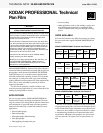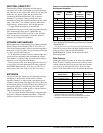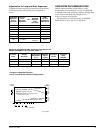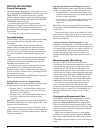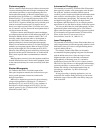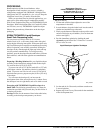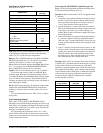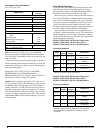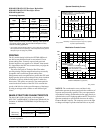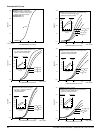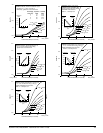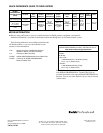
2 KODAK PROFESSIONAL Technical Pan Film • P-255
SPECTRAL SENSITIVITY
Technical Pan Film has reasonably uniform spectral
sensitivity at all visible wavelengths out to 690 nanometres
(nm). Because of this extended red sensitivity, red areas and
flesh tones may appear lighter than they would with
conventional black-and-white films. This is often an
advantage. For example, it helps conceal some skin
blemishes and often adds a pleasing luminous quality to skin
tones. (This effect is less evident in portraits made in the
shade outdoors, because there is less red light present.)
To approximate the response of conventional
panchromatic films more closely, make exposures through a
color-compensating filter such as a KODAK Color
Compensating Filter CC40C or CC50C (cyan). With this
filter, no exposure compensation is necessary; however,
there may be a slight loss in sharpness.
STORAGE AND HANDLING
High temperatures or high humidity may produce unwanted
quality changes. Store unexposed film at 75°F (24°C) or
lower in the original package. Always store film (exposed or
unexposed) in a cool, dry place. For best results, process film
as soon as possible after exposure.
Load and unload roll-film cameras in subdued light, and
rewind the film completely before unloading the camera.
Total darkness is required when you remove film from the
magazine or load and unload film holders.
Protect processed film from strong light, and store it in a
cool dry place. For more information on storing negatives,
see KODAK Publication No. E-30, Storage and Care of
Photographic Materials—Before and After Processing.
EXPOSURE
The speed of this film depends on the application, the type
and degree of development, and the level of contrast
required. Therefore, no single speed value applies for all
situations. (Speed ratings may range from a low of EI 16 for
pictorial photography to a high EI 320 for microfilming. Use
the exposure indexes in the following table with meters
marked for ISO, ASA, or DIN speeds or exposure indexes.
They are intended for trial exposures.
You can expose this film with daylight or tungsten light.
Exposure to tungsten illumination produces a 10-percent
increase in speed and a 5-percent increase in contrast.
Exposure- and Contrast-Index Values for Various
Development Conditions
For pictorial applications, use EI 25/15° and process the
film in KODAK TECHNIDOL Liquid Developer. (Refer to
“PROCESSING.”)
For high-contrast reversal-processing applications, use
EI 64/19° to produce slides from high-contrast subjects such
as line art. Process the film with the KODAK
PROFESSIONAL T-MAX 100 Direct Positive Film
Developing Outfit.
Filter Factors
Multiply the normal exposure by the filter factor indicated
below. If you use a through-the-lens meter, take the meter
reading without the filter over the lens, and then calculate
your exposure by using the filter factor. Where no filter
factor is listed in the table, no test was made with that filter.
Contrast
Index
KODAK
Developer
Development
Time
(minutes at
68°F [20°C])
Exposure
Index
High 2.50 DEKTOL 3 200
2.40 to 2.70 D-19 (1:2) 4 to 7 100 to 160
2.25 to 2.55 D-19 2 to 8 100 to 200
1.20 to 2.10 HC-110 (Dil B) 4 to 12 100 to 250
1.25 to 1.75 HC-110 (Dil D) 4 to 8 80 to 125
1.10 to 2.10 D-76 6 to 12 64 to 125
1.00 to 1.50 MICRODOL-X 8 to 12 32 to 50
0.80 to 0.95 HC-110 (Dil F) 6 to 12 32 to 64
Low
0.50 to
0.70
TECHNIDOL
Liquid
5 to 11 16 to 25
KODAK WRATTEN
Gelatin Filter
Tungsten
Filter Factor
*
* Based on a 1-second exposure and development in KODAK HC-110
Developer (Dilution D) for 8 minutes at 68°F (20°C).
Daylight
Filter Factor
†
† Based on a 1/25-second exposure and development in KODAK
TECHNIDOL Liquid Developer for 9 minutes at 68°F (20°C).
No.8 (yellow) 1.2 1.5
No. 11 (yellowish green) 5 —
No. 12 (deep yellow) 1.2 —
No. 15 (deep yellow) 1.2 2
No. 25 (red) 2 3
No. 47 (blue) 25 12
No. 58 (green) 12 —



